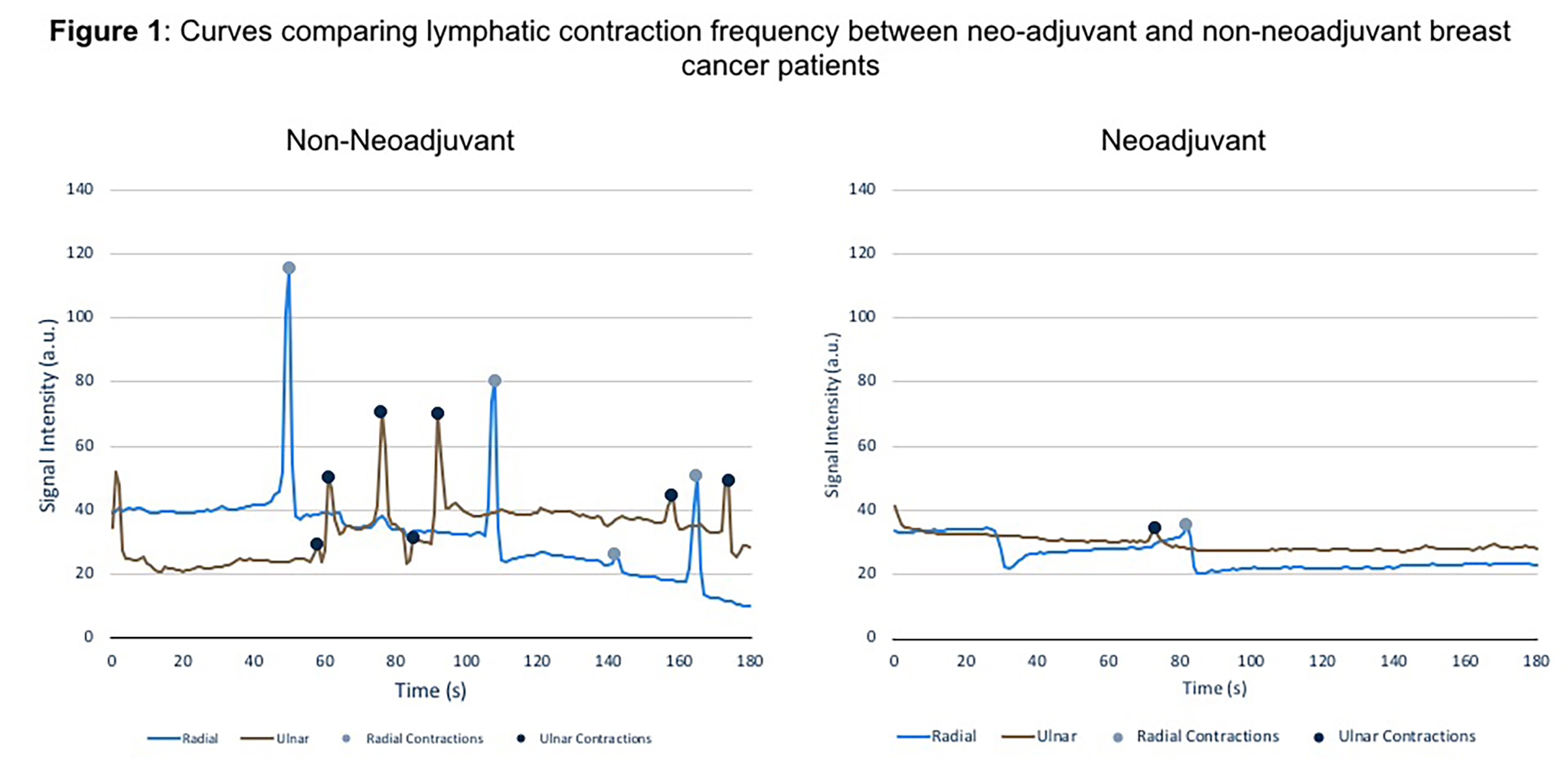Taxane-Based Neoadjuvant Chemotherapy Adversely Impacts Lymphatic Contractility Rates
Anna R. Johnson1, Melisa Granoff, BA1, Jordan Broekhuis, MD1, Echoe Bouta, PhD2, Timothy Padera, PhD2, Bernard T. Lee, MD MBA MPH FACS1, Dhruv Singhal, MD1.
1Beth Israel Deaconess Medical Center, BOSTON, MA, USA, 2Massachusetts General Hospital-Division of Radiation Oncology, BOSTON, MA, USA.
Background: Taxane-based chemotherapy is considered an independent risk factor for the development of lymphedema in certain studies. The quantitative effect of neoadjuvant taxane-based therapy on lymphatic contractility remains unexamined. Indocyanine green (ICG) fluorescent lymphography permits the identification of superficial lymphatic channels and allows for evaluation of their function using real-time near-infrared imaging technology. In this study, we quantify and compare lymphatic contractility in unilateral breast cancer patients undergoing pre-operative ICG lymphangiograms.
Methods: Pre-operative ICG lymphangiograms were obtained on consecutive patients with unilateral breast cancers and nodal disease prior to the oncologic resection. Two ICG injections of the dorsal hand were performed, radial and ulnar, and the sites were recorded for 3 minutes. All ICG videos were processed using the StackReg plugin in Image-J. Multiple regions of interest (ROIs) were selected on each lymphatic channel and signal intensity was analyzed to generate contractility curves. Individual peaks in signal intensity corresponded with lymphatic contraction. Each contraction was identified using a systematic, algorithmic approach.
Results: Eighteen patients with unilateral breast cancers requiring axillary nodal dissection underwent pre-operative ICG lymphography. The mean patient age was 59.8 years and average BMI was 28.3. Eight of the 18 patients underwent taxane-based neoadjuvant chemotherapy. The mean contraction frequency in patients who received neoadjuvant taxane-based chemotherapy was 1.96 contractions/minute (c/m) compared to 4.06 c/m if no neoadjuvant chemotherapy was delivered (p=0.1).
Conclusions: Utilizing a novel method for quantifying and evaluating lymphatic contractility patterns during ICG lymphangiography, we have noted differences in rate of contractility based on whether a patient received taxane-based neoadjuvant chemotherapy. A larger patient population with longer follow-up time is needed to validate this finding. However, this observation may have important implications in guiding timing of surgical intervention, surveillance frequency, and post-operative therapeutic interventions.
Table 1: Patient Demographics
| ID | Age | BMI | Neoadjuvant Chemotherapy (Y/N) | Chemotherapeutic regimen | Disease laterality |
| 1 | 47 | 51.6 | Y | ddAC+taxol | L |
| 2 | 60 | 31.7 | Y | ddAC+taxol | L |
| 3 | 62 | 25.2 | Y | ddAC+ taxol +Herceptin Pertuzumab | L |
| 4 | 54 | 27.2 | Y | ddAC+taxol+Trastuzumab+Pertuzumab | R |
| 5 | 38 | 28.8 | Y | ddAC | L |
| 6 | 79 | 26.6 | Y | ddAC+taxol | R |
| 7 | 84 | 27.8 | Y | D8 CMF | R |
| 8 | 65 | 24.2 | Y | ddAC+ taxol | L |
| 9 | 45 | 23 | Y | ddAC+taxol | R |
| 10 | 69 | 25.8 | N | L | |
| 11 | 70 | 23.6 | N | L | |
| 12 | 52 | 30 | N | R | |
| 13 | 59 | 37.4 | N | L | |
| 14 | 51 | 30.1 | N | L | |
| 15 | 56 | 24.7 | N | L | |
| 16 | 45 | 18.4 | N | R | |
| 17 | 72 | 26.9 | N | L | |
| 18 | 68 | 25.9 | N | R | |
| MEAN | 59.8 | 28.3 | |||

Back to 2018 Abstracts




